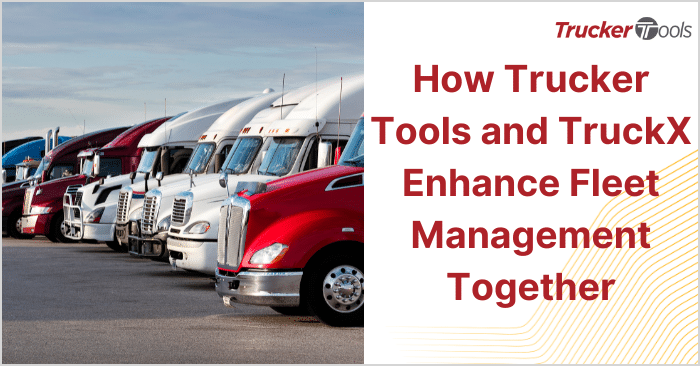Every quarter for the last two years, we’ve invited thought leaders from across logistics to meet virtually and discuss the state of the industry. We recently invited our panel of experts to return to talk about the historic demand for trucking capacity and whether it will remain elevated throughout 2022. In the most recent webinar, Trucker Tools’ CEO and Founder Prasad Gollapalli was joined by FTR Transportation Intelligence’s Lead Analyst Avery Vise, JOC’s Senior Editor of Trucking and Domestic Transportation Bill Cassidy, and Logistics Management Magazine’s Contributing Editor John Schulz. The panel discussed some of the greatest challenges that freight brokers and logistics providers like you faced in 2021, as well as predictions of what you can expect from the remainder of 2022.
Consumer Spending Biggest Driver of U.S. Economy, Demand for Freight/Capacity
Among the biggest challenges that you likely faced in 2021 as a freight broker or logistics business were an unpredictable economic recovery following the initial outbreaks of COVID-19, changes to consumer spending habits, supply chain disruption, and capacity and labor shortages. According to Vise, it’s consumer spending habits that have had and will likely continue to have the most significant impact on transportation.
“You could slice and dice consumer spending many different ways, but I think the most important thing to take away from this is that all of this strength we’re seeing within trucking and freight is because of the extraordinarily high level of consumer spending,” said Vise. “Yes, we are seeing some pockets of real strength on the industrial side, but by and large the strength of the economy is the reason, fundamentally, that the trucking industry is so hot right now. Yes, there are a whole bunch of disruptions, but without consumer spending, those disruptions would be irrelevant.”
Cassidy noted that while the pandemic has shifted consumer spending from services to physical goods, that may shift back in the other direction sometime in 2022. Schulz noted that the economy and consumer spending levels have returned to pre-pandemic levels, despite significant shortages of certain goods.

How the Auto Industry Might Impact Truck Capacity in 2022
In the webinar, Vise also spoke of the outsized role that the automotive industry plays in consumer spending and the capacity crunch. If you subtract the automotive industry from the equation, retail inventories are actually quite strong. They’re much stronger than they would have been without the pandemic and the federal government’s stimulus payments. According to Vise, the semiconductor shortage has been the story for the entire industrial side of supply chain. He went on to say that the semiconductor shortage is going to keep demand for drivers stronger than it might seem it should be.
“Automotive accounts for about 20 percent of the total truckload market, which is a tremendous volume,” said Schulz. “This sucks up a lot of capacity in both the TL and, to a lesser degree, the LTL market. It’s almost a slight blessing actually that auto sales have been crimped a little bit by the supply chain situation, but eventually Americans are going to buy more cars. I was talking to a trucking executive the other day who buys a lot of trucks. He’s a major carrier and he had about 15 to 20 trucks in his order withheld because the manufacturer could not get metal brackets for the outside mirrors on the doors. That’s an example of the weird kind of supply chain kinks that are in the system right now that I have to believe will work themselves out to some degree at some point. If the auto industry came roaring back in the next year or two, that is going to put a further crimp on capacity beyond what we have today, which is very tight capacity, so it’s a conundrum in the making.”
Gollapalli noted that semiconductor factories cannot be built overnight and start producing chips immediately. Intel reportedly is expanding its semiconductor manufacturing capacity, but until production begins, automotive and truck related shortages will continue to impact available capacity.
A Recipe for Success in 2022 for Freight Brokers and 3PLs
“I think brokers would be wise to look at new models as they go in the 2022 and what I mean by that specifically is they should look more at dedicated operations and how they can use the capacity that they offer to shippers to simulate or create dedicated relationships,” said Cassidy. “The kind of gold rush that’s been available in the spot market isn’t going to last forever, and what happens when that begins to recede? Shippers that I talk to are really interested in putting more of their operations into dedicated in the future. Ten years ago, I don’t think we would have talked about brokers and 3PLs and dedicated in the same breath. Whether they’re long term contracts or they’re pop up fleets to meet a specific need for capacity at a specific time, I think that is a really interesting opportunity for brokers in 2022 and I’m sure we’re going to see more of that.”
Gollapalli closed the discussion by pointing out that brokers who use technology to aggregate smaller carriers at a much faster rate are seeing the greatest success in the industry. Successful brokers also are using repeat business with the same carriers to increase the density of their relationships with small carriers. In many ways, the freight brokers and 3PLs achieving the most success are almost acting as a large carrier for a shipper, as opposed to functioning as a spot market broker. For more of the conversation between our panel of analysts, watch the full webinar on demand.






